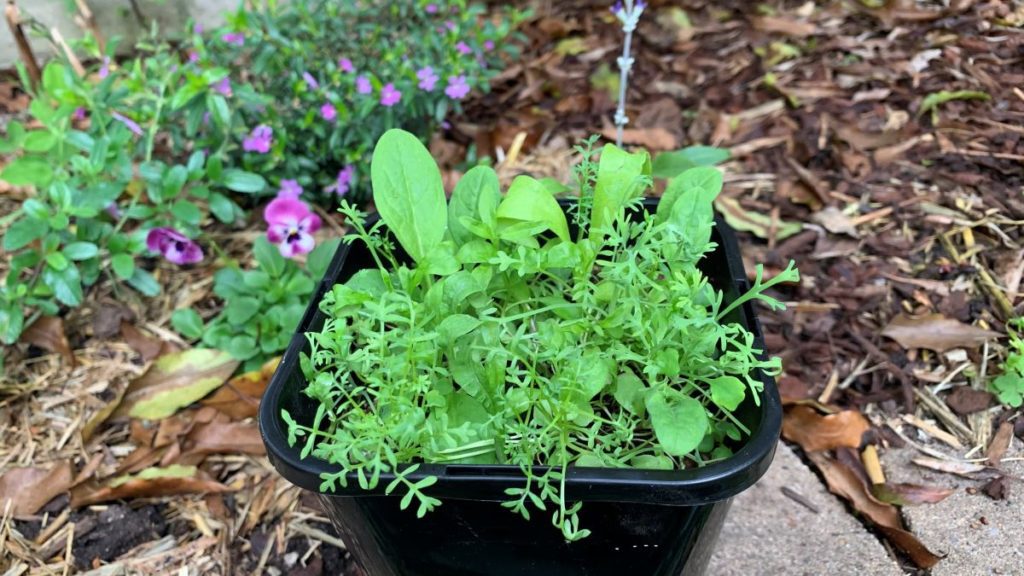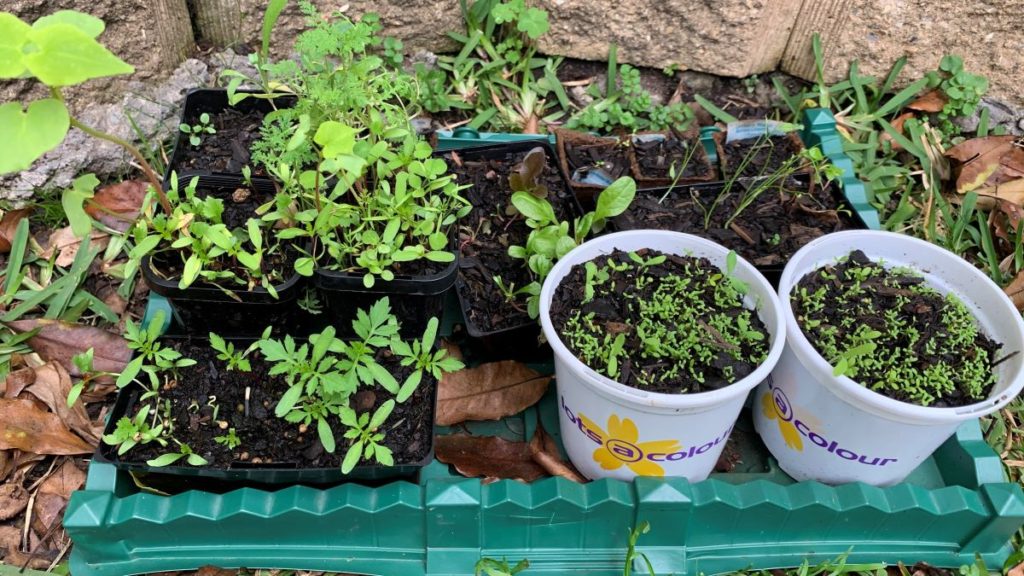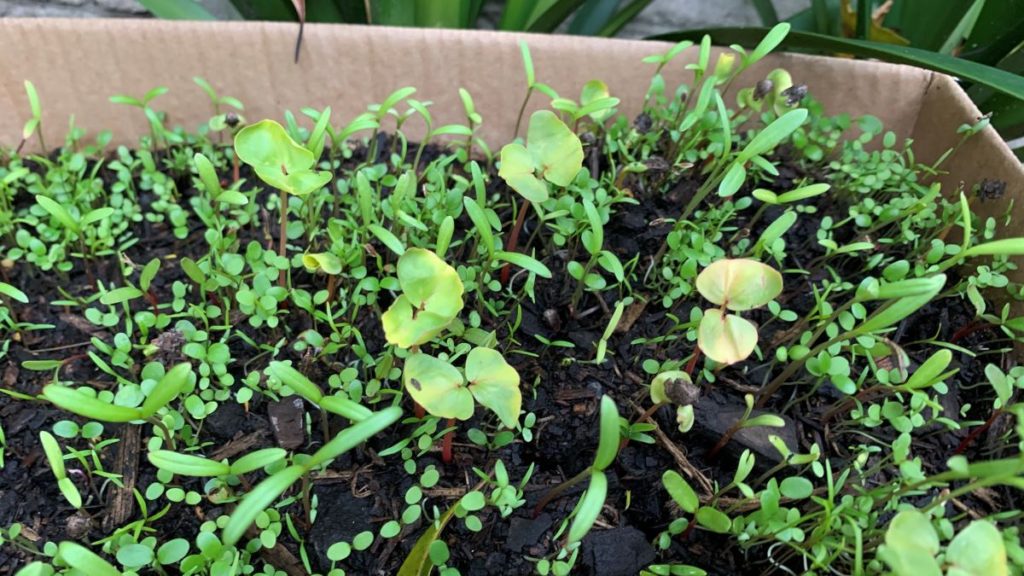Seeds can germinate and grow a small root but if they are not sprouting leaves it may be because they have dried out, the weather is too cold, due to damping off, they were planted too deep or from poor quality seeds. To successfully sprout seeds make sure they have bright light, temperatures between 65-75 degrees Fahrenheit and are given extra nutrients after they sprout their second set of leaves.
Top 6 reasons why seeds will germinate but not sprout
There are lots of reasons why your seeds will get a good start and grow their first root. The seed will split open and the seed will start to grow but sometimes that is where it can stop. Here are the top things that can stop your seed from sprouting its first two leaves called cotyledons.
The seed dried out
The top reason why seeds fail at this stage is the soil is allowed to dry out. You may see the top of the soil crack as the new seed has sent down a root and moved in the soil but if the seed dries out at this stage it can die off quickly.
Seeds need to be kept moist until the seedling is at least 2-3 inches high for it to grow.

To solve this problem, check your seeds everyday and use a cover for seed trays. This will keep the humidity in and keep the soil moist for longer. Remember to open up the air hole to allow extra moisture to escape but this is an easier way to keep your soil moist for longer.
Check out this seed starting kit from Amazon below.

Weather is too cold
Temperatures below 65 degrees Fahrenheit will make it difficult for seeds to sprout. Seeds like warmer temperatures up to around 75 degrees Fahrenheit to grow their first roots and leaves.
A seed raising kit with a cover is a good way to keep the temperature consistent and warm enough for seeds to sprout and grow. Small greenhouses are also great for cold areas where you are looking to grow lots of seeds.
For a simple solution, the top cut of a clear soda bottle can be placed over your seeds to keep them warmer and also prevent bugs from coming in and eating young seed leaves. Take the lid off the soda bottle so that extra moisture can escape and you have a low cost seed raising kit.
Wrong seed raising mix
Using a seed raising mix that becomes too compact can stop seeds from sprouting leaves. While the seed might send down its first root, this can quickly rot if it cannot get enough oxygen.
Coconut coir can quickly become too compact if it is used in large amounts so works best if it is mixed with perlite for oxygen and compost for extra organic matter.
Another option is to use a good quality seed raising mix. These will have fine particles that will allow the seed the room to send down roots and grow leaves. Potting mix with large particles can also stop seeds from growing through successfully.
To use regular potting mix as seed raising mix, run it through a garden sieve first to remove the larger pieces. This will make sure that your seeds newly sprouted leaves can pop through the soil easily.

Too much sun and heat
Young seed leaves are very delicate and too much heat from direct sun or from an indoor heat lamp can quickly damage new leaves. The root can grow under the ground but new leaves can yellow and die if hot sun or bright growing lamps are too close or too hot.
Keep temperatures in the range of around 65-75 degrees Fahrenheit and if you are growing seeds outside, check them regularly. Watering well can help to protect then but you may need to add a temporary shade over the top on very hot days.
Seeds planted straight into garden beds are most likely to suffer from sunburn so place shade cloth over the top of the seeds on very hot days to protect them.
Too much water
Seeds can rot in the soil if they are given too much water. The seed can sprout a new root but leaf shoots can rot and they will not germinate completely.
Seeds need to be kept moist but burying them too deep in the soil can mean that the seed rots under the soil before they sprout through. Seeds can send leaves up a certain level but if they are buried too deep the leaves will not make it through.
The solution to this is to only plant the seeds around the depth that they are wide. For small lettuce seeds, this means they only need around a 2mm covering of soil. Larger seeds like peas can be buried up to 1 inch lower in the soil because they are a larger seed with a strong sprout.

Damping off
Seedlings can sprout roots but can die quickly before leaves sprout through the soil due to damping off. This is where seeds are affected by soil fungi which can kill the seedlings as they grow.
You will often see a white fungus grow around the seed if this is the problem.
To avoid this problem it is important to sterilize any pots or growing containers before planting seeds into them. The containers can carry the fungus that causes damping off and spread it to your new seeds.
Check out my previous article here to find out how to disinfect pots without using bleach.
Using good quality potting mix is also a great way to prevent damping off as it is less likely to be carrying these fungus types that will cause your seeds problems.
Top 4 tips to sprout seeds successfully
Here are the top things to remember when growing seeds that will bring you success.
Bright light
Seeds will grow and sprout best when they get bright light and warm conditions. Plant seeds in spring and fall in your garden when the soil temperatures are still warm and the sun is still shining. This will get your seeds growing well before the weather gets too cold or too hot.
Once seeds have grown 2-3 inches high, surround them with mulch to keep the soil temperature more stable and prevent weeds.
Extra nutrients
Once seeds have grown their second set of leaves they will need extra nutrients to keep growing. Seeds will have run out of the nutrients they are getting from the seed and most seed raising mixes are low in nutrients.
Give seedlings a boost of a weak liquid fertilizer or plant them out into your garden beds or into new potting soil that has extra added nutrients. A slow release fertilizer like pelleted chicken manure is also a great way to support seeds to keep growing.

Mulch
Mulching seedlings once they have sprouting and growing up to 2-3 inches will keep them growing strong. Straw or sugar cane mulch is great for vegetable seedlings or strawberries as it will break down over the growing season and be ready to dig into the soil when you are ready to replace your plants.
Mulch will also stop weeds meaning your seedlings will not need to compete for water or nutrients.

Good quality seeds
Seeds that do not sprout or grow well it can be a problem with the seeds. Old or damaged seeds can be difficult to grow well. Check the use by date on your seeds to see if they are still likely to grow.
Store opened seed packets in dry, clean glass jars with lids. Place a piece of paper towel in the jar to absorb extra moisture to keep your seeds dry and ready to sprout when you plant them.
Seeds germinated but not sprouting – Summary
Seed can sometimes get off to a great start and send a small root into the soil but that can be it. Seed that fail to grow their leaves can be disappointing but don’t give up. Try again in a new, clean pot, with new potting soil and try my trick and place a clear soda bottle over the top. This will help you to grow your seeds with success.
I am an accredited practicing dietitian, experienced gardener and a dedicated cook. I love writing and sharing my experience so you can learn from my successes and mistakes.

Comments are closed.